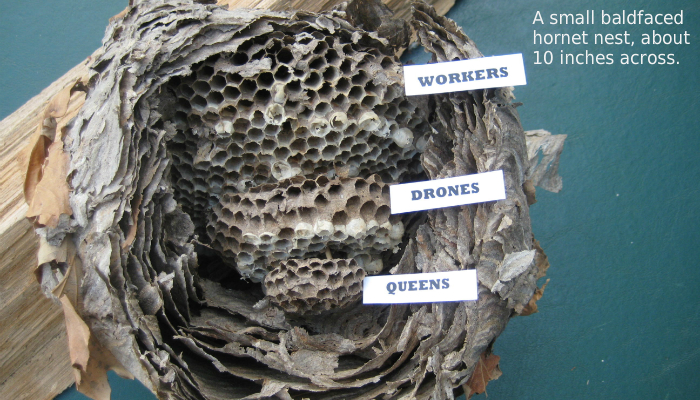The Baldfaced Hornet

These are nasty females you do not want to meet in summer, so now is the time to get a good look at their life cycle by observing their now-empty nest.
The pregnant queen overwinters alone in the ground, coming out in spring to build a little paper-wrapped nest up in the bushes. Her first brood is all female workers whose assignment is to grow the colony by making more paper, hunting dinner, and raising more workers. By midsummer the nest is fist-sized or larger and the queen switches to producing drones who grow up in their own separate apartment complex hanging below the worker cells, all enclosed by the growing outer paper shell. Finally, in late summer the queen switches hormones again and produces fertile queens, who also have their separate floor, below the drones. As frost approaches, the drones and new queens take off on a mating flight with other nests, and the now-pregnant queens burrow into the soil to begin the cycle anew, while all the others die.
So in winter the nest hangs empty, or maybe still containing a few dead queens that hadn’t matured enough to fly off. If we have an unusually early winter, the old queen might still have been making drones and never had time to make queens.
By late summer, these nests get big, often the size of a basketball, sometimes the size of a peck basket. And they are usually well hidden in dense leaves. One of the most common nasty encounters folks have with them is mowing their lawn and bumping into an occupied bush. The whole colony of workers comes pouring out and can sting multiple times, which usually sends the victim to the hospital. Because the nest is so well insulated with multiple layers of paper, they can maintain a high body temperature and come shooting out of the nest like little missiles, no warm up exercises required.
But in early winter, with the leaves fallen, the empty gray nests are quite conspicuous, and you can cut one down and carefully snip it open with scissors to see how it evolved. In the photo, the three stacked apartments are labeled. Also note the many separate outer layers of paper with airspaces between for insulation. The outer layers also incorporate the branch it originally hung from, leaves and all, giving it more strength and structural stability – it is now twig reinforced paper.
But by midwinter, now exposed, and with no workers to maintain it, the paper house begins to tatter in the wind. When out for a walk you occasionally will notice distinctive bits of gray paper skittering over the snow and can backtrack upwind to find the slowly disintegrating nest. And somewhere out there beneath your feet, the dormant young queens are biding their time, taking their chances with the mice and the parasites.
And the way to avoid a summer encounter with them in your yard, is to use your field guides to learn to identify them. Then note whether you see them working around a particular area hunting insects or salvaging dead wood for paper.
There are so many ways to enjoy nature and support conservation – from supporting education programs like Bur Oak Land Trust’s upcoming Prairie Preview environmental forum and Spring Family Day, to taking walks in nature, to volunteering to clear land of invasive species, to learning about insect, bird, animal, and plant life cycles! These hornets are just one of the many examples nature shows us of uniqueness and adaptability.


